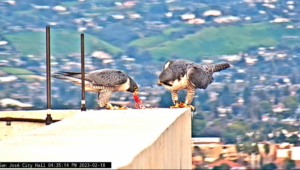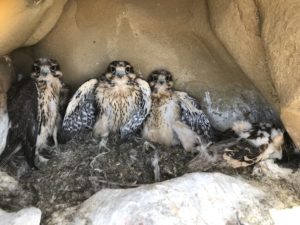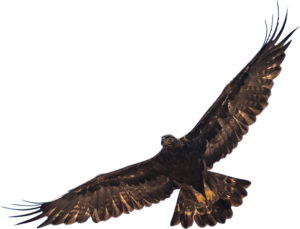Mount Diablo’s woodlands and canyons provide habitat for a fantastic variety of raptors, from kestrels to golden eagles (of which the northern Diablo Range hosts perhaps the world’s densest population). In the 1950s, however, the mountain lost one of its key raptor species when peregrine falcons, which had nested on cliffs in and near the park, were extirpated due to DDT-related eggshell thinning combined with egg and bird collecting. Peregrines were particularly vulnerable to eggshell-thinning because they prey mainly on birds, which, because of their insect diet, tend to have high pesticide concentrations in their tissues.
Although contamination levels decreased after DDT was banned in 1972, peregrines had become too scarce to return to Mount Diablo on their own. In 1989, Gary Beeman, a wildlife biologist and SMD volunteer, led an effort to return nesting peregrines to the mountain. In alliance with other groups, including the Lindsay Wildlife Museum in Walnut Creek, peregrine chicks were “cross-fostered” in nests of the closely related prairie falcon in the park. (Prairie falcons survived DDT because the species feeds largely on herbivorous rodents, which have lower pesticide levels.) By 1994, reintroduced peregrines had found mates and were nesting at two local sites. The population has since returned to its historic level.
Prairie falcons are the subject of a recent telemetry study that should help in the planning for wildlife corridors. The falcons may travel long distances from their nest sites to find food. With financial help from SMD, a biologist with the East Bay Regional Park District is placing transmitters on seven local birds. About half the birds nest in Mount Diablo State Park, while the others make their homes at Morgan Territory and Brushy Peak Regional Preserves. This study should provide information about areas that are important to survival not only of prairie falcons but of other raptors.
The most spectacular native “raptor” of all may return to Mount Diablo if the attempt to restore the California condor succeeds. (Once classed in the same group as hawks and eagles, condors and turkey vultures are actually more closely related to storks.) One or two individuals of the species, which has been reintroduced at Big Sur and Pinnacles National Monument, may have been sighted near Morgan Territory in 2004. The sightings remain unconfirmed, but Mount Diablo’s cliffs would make fine condor nesting habitat, as they must have in prehistory.

.jpg)



